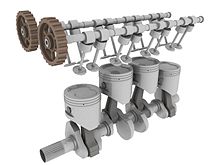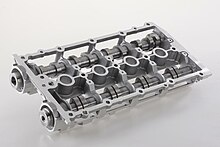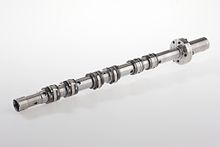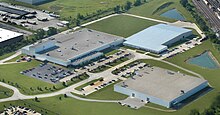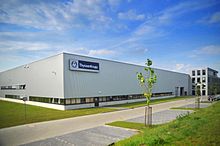Thyssenkrupp Camshafts
| thyssenkrupp Camshafts
|
|
|---|---|
| legal form | Group of companies |
| founding | 1941 |
| Seat | Ilsenburg , Germany |
| management | Frank Altag,
Patrick Buchmann, Peter Wiesner |
| Number of employees | > 3600 (December 31, 2018) |
| Branch | Automotive industry |
| Website | thyssenkrupp-camshafts.de |
The thyssenkrupp Camshafts is a group of companies within the ThyssenKrupp -Konzerns that from 1941 on behalf of the entrepreneur Emil Georg Buehrle and of dealer Rudolf Ruscheweyh in Liechtenstein emerged based munitions factory pressing and punching Eschen (PSE). The group's head office and two production plants are located in Ilsenburg (Germany).
In 1994 the first series production of the assembled camshaft for the customer Ford took place. As a result, new plants were opened in Danville (Illinois) (USA), Ilsenburg (Germany), Dalian (China), Chemnitz (Germany), Changzhou (China), Pocos de Caldas (Brazil), San Miguel de Allende (Mexico) and Jászfényszaru (Hungary) opened.
The company is one of the leading manufacturers of assembled camshafts , other valve train components and cylinder head covers for cars , trucks and motorcycles.
history
The munitions factory Press- und Stanzwerk Eschen (PSE) was founded in Eschen in 1941 during the Second World War on behalf of the industrialist Emil Georg Bührle and the arms dealer Rudolf Ruscheweyh . Important factors for this decision included the stable power supply from the Vorarlberg power plants , the cheap labor that was still available in Liechtenstein and the fact that no war profit tax was levied in the principality. Founder and first director was the trustee Max Held. He also managed the assets of Ruscheweyh. The industrial company , which quickly grew to over 300 employees, produced ammunition components , which from spring 1942 were supplied indirectly via Oerlikon-Bührle , primarily to the Nazi state . After large sales of bullet casings continued to be achieved during the Korean War from 1950 to 1953, arms production became less and less profitable and was discontinued in 1980. From 1946 the company specialized in the manufacture of screws. The first massive forming for the automotive industry took place in 1967. The company, which was renamed Press- und Stanzwerk AG (Presta) at this point in time, also began developing camshafts in 1985 .
After the sale of Press- und Stanzwerk AG (Presta) to Krupp in 1991, camshaft activities continued and the first series production of the camshafts built by Presta began in Eschen in 1994. At the same time, a new company was founded in Danville , Illinois, for massive forming and camshafts.
With the merger of the companies Thyssen and Krupp to ThyssenKrupp in 1999, Krupp Presta was renamed ThyssenKrupp Presta again . A year earlier Presta founded a new company in Ilsenburg. In 2005 Presta built a plant in Dalian (China), in 2006 one in Chemnitz .
In 2007 the ThyssenKrupp Presta group of companies employed around 5,500 people worldwide. The factory in Ilsenburg alone had 450 employees, produced 8.4 million camshafts and had developed into the largest camshaft factory in the world.
Until 2007, the products of high-precision solid forged parts, steering systems, assembled camshafts and valve train systems were manufactured in the ThyssenKrupp Presta group of companies. With the establishment of the ThyssenKrupp Presta TecCenter at the end of 2007, ThyssenKrupp Presta was separated into the new divisions ThyssenKrupp Steering and ThyssenKrupp Presta Camshafts. Since then, valve train systems and assembled camshafts have been developed and manufactured under the brand name 'ThyssenKrupp Presta Camshafts'. Your lead company is thyssenkrupp Presta Ilsenburg GmbH.
A second plant began production in Ilsenburg in 2013, in 2014, 2015, and plants in Changzhou (China), Pocos de Caldas (Brazil), San Miguel de Allende (Mexico) and Jászfényszaru (Hungary) followed in 2017 .
Since the parent company was renamed in 2015, the thyssenkrupp Camshafts group of companies has been part of the 'Components Technology' business area of thyssenkrupp AG .
Products and technology
Assembled camshafts
The camshaft plays a central role in the valve train of an internal combustion engine by controlling the opening and closing of the intake and exhaust valves in accordance with the design.
While many camshafts are still cast or forged in one piece today, assembled camshafts consist of individual parts that are assembled together on a tube. The idea for this is already more than 70 years old. Built camshafts were introduced into the series production of car engines in the early 1990s after suitable, inexpensive and process-capable joining methods were available.
The procedure has several advantages:
- Weight savings of 30 to 40% compared to a conventional non-built camshaft
- Transmission of high dynamic and static torques
- Combination of high-quality cam materials with inexpensive materials for the less stressed parts
- The Presta process allows 100% automatic monitoring of all essential process parameters and geometric features during assembly
The above-mentioned advantages of the built-in camshafts, which were previously only found in the car market, play an even more important role for truck camshafts. The first series production of built camshafts for truck applications has already been implemented at the thyssenkrupp Presta Chemnitz GmbH site.
Camshaft modules with potential for further component / function integration
The increasing variety of technologies in the powertrain requires engine manufacturers to increase flexibility in the process chain as well as an associated reduction in production costs via e.g. B. modularization or additional function / component integration. Thyssenkrupp Camshafts is taking this trend into account with the development of camshaft modules (PICA - Presta Integrated Camshaft Assemblies). The implementation of the trend was ensured through the further development of the tried and tested Presta process for assembling built-in camshafts (Presta²).
In contrast to the state of the art, with this method the camshafts are built in the bearing structure (bearing blocks or frames, cylinder head covers) with finished components. The well-known advantages such as the robust force and form fit as well as the 100% quality data acquisition for each connection are retained. Since the integration of the bearings in the camshaft modules enables a closed design of the slide bearings , a significant reduction in the friction in the bearings and thus a reduction in the CO 2 emissions of the internal combustion engine can be achieved. A further improvement can be achieved through the optional use of roller bearings . One example of this is the eccentric shaft of the Valvetronic variable stroke adjustment system from BMW .
Variable valve control
Variable valve control means the possibility of being able to vary the opening and / or closing angle and / or stroke of the gas exchange valves of an internal combustion engine. There are various technologies that enable these functionalities, but almost all variants have a direct interface to the camshaft.
In the case of a simple shift in the cam lift curves of a camshaft, a camshaft adjuster is attached to the end of the camshaft. By working with suppliers of camshaft adjusters, costs can be saved and the function of the camshaft adjuster can be improved by optimally designing the interface between camshaft and camshaft adjuster. Among other things, it is possible to fix the camshaft adjuster directly on the camshaft during the camshaft assembly.
An extension of this concept is the ConcentricCam solution (German: camshaft in a camshaft). It is similar to the concept used by Chrysler in the Dodge Viper , whereby part of the cams are tightly bound to the outer shaft of the camshaft assembly and part of the cams are fixed to an inner shaft. By rotating the inner shaft relative to the outer shaft by means of a camshaft adjuster, advantages are achieved in terms of increased performance and reduction of exhaust gas, for example: by using a Miller cycle . Furthermore, a variation of the valve lift opening duration is possible, which allows an internal exhaust gas recirculation to be realized especially for diesel engines .
Due to the increasing awareness of exhaust emissions and the legislative need to reduce the CO 2 emissions of the internal combustion engine, fully variable valve lift control systems are also of great importance, especially in gasoline engines. Like the BMW Valvetronic and FIAT MultiAir , the PDVC system (Presta Delta Valve Control System) enables the valve lift to be changed while the engine is running. This so-called “dethrottling of the engine” and other effects reduce consumption and exhaust emissions in the partial load range .
Electromobility
As a specialist in shaft-hub connections , the development and manufacture of components for electric drives is also part of the thyssenkrupp Camshafts product portfolio. The focus of the development is on rotor and gear shafts of electrified drive systems and axles, which differentiate themselves from the current state of technology through alternative manufacturing processes, materials and innovative component and functional integration and are validated on the basis of specific target vehicle requirements.
A hollow cylindrical rotor shaft made from several components is already in series production. One of the advantages of this structure is the ability to scale the machine's performance by simply adapting the pipe length. The bearing journals can be designed in the same way. Further optimization potentials are u. a. examined by
- Reacting whole rotors with joined sheet packages (using the example of rotors permanently excited synchronous machines )
- Integration of engine functions in the rotor cavity (e.g. rotor cooling, sensors)
- Design of gear shafts in purely electric drive trains
Synergies and innovative ideas arise from the group-internal potential in the cooperation with thyssenkrupp Magnettechnik ( permanent magnets ), thyssenkrupp Systems Engineering (assembly planning) and thyssenkrupp Electrical Steel (material development for high-strength electrical strips ) as well as the cooperation with external development partners.
Locations

Chemnitz (Germany)
- Activities: Series production & research and development center
- Employees: 280 (December 31, 2018)
- Company: thyssenkrupp Presta Chemnitz GmbH in Chemnitz
Dalian (China)
- Activities: Series production
- Employees: 791 (December 31, 2018)
- Company: thyssenkrupp Presta Dalian Co. Ltd. in Dalian (China)
Danville (USA)
- Activities: Series production
- Employees: 387 (December 31, 2018)
- Company: thyssenkrupp Presta Danville LCC in Danville (Illinois, USA)
Eschen (Liechtenstein)
- Activities: technology center, prototype production and small series production
- Employees: 260 (December 31, 2018)
- Company: thyssenkrupp Presta TecCenter AG in Eschen (Liechtenstein)
Ilsenburg (Germany)
- Activities: Series production & headquarters
- Employees: 782 (December 31, 2018)
- Company: thyssenkrupp Presta Ilsenburg GmbH in Ilsenburg
- Activities: Series production
- Employees: 369 (December 31, 2018)
- Company: thyssenkrupp Valvetrain GmbH in Ilsenburg
Changzhou (China)
- Activities: Series production
- Employees: 291 (December 31, 2018)
- Company: thyssenkrupp Valvetrain China Ltd. in Changzhou
Poços de Caldas (Brazil)
- Activities: Series production
- Employees: 88 (December 31, 2018)
- Company: thyssenkrupp Brasil Ltda Valvetrain Division in Poços de Caldas
San Miguel de Allende (Mexico)
- Activities: Series production
- Employees: 85 (December 31, 2018)
- Company: thyssenkrupp Components Technology de México SA de CV
Jászfényszaru (Hungary)
- Activities: Series production
- Employees: 292 (December 31, 2018)
- Company: thyssenkrupp Components Technology Hungary Kft.
Managing directors
- Frank Altag ( Chief Executive Officer )
- Patrick Buchmann ( Chief Financial Officer )
- Peter Wiesner ( Chief Operating Officer )
literature
- Michael Pyper: Built camshafts (= library of technology . Volume 251 ). Verlag Moderne Industrie, 2003, ISBN 3-478-93255-6 .
- Andreas Stapelmann, Peter Wiesner: Valve train and cylinder head: Innovative component integration along the camshaft (3rd VDI symposium) . VDI-Verlag, November 2008.
- Jonathan Heywood, Jürgen Meusel, Andreas Stapelmann: Innovative integrated valve train solutions . Haus der Technik, March 2009.
- Jonathan Heywood: New cylinder head concept - reducing costs, mass and friction losses (November 2009) . ATZ, October 2009.
Web links
Individual evidence
- ↑ Arms trade: cannons for teaching . In: Spiegel Online . tape 37 , September 9, 1953 ( spiegel.de [accessed September 9, 2019]).
- ↑ Arms trade: cannons for teaching . In: Spiegel Online . tape 37 , September 9, 1953 ( spiegel.de [accessed September 9, 2019]).
- ↑ Hanspeter Lussy: Max Held. In: Historical Lexicon of the Principality of Liechtenstein online. Liechtenstein Institute, 2013, accessed on September 9, 2019 .
- ^ Christoph Maria Merki: ThyssenKrupp Presta AG. In: Historical Lexicon of the Principality of Liechtenstein online. Liechtenstein Institute, 2013, accessed on September 9, 2019 .
- ↑ Hot Frog: ThyssenKrupp Presta TecCentre October 2007
- ↑ ThyssenKrupp: Components Technology May 2013
- ↑ ThyssenKrupp Presta Camshafts: Animation of the Presta assembly process May 2013
- ↑ Trade press release: The assembled camshaft for commercial vehicles . April 2005
- ↑ Variable cam timing . In: Automobiltechnische Zeitschrift (ATZ)
- ↑ Animation: Concentric Camshafts ( Memento of the original from March 26, 2009 in the Internet Archive ) Info: The archive link was inserted automatically and has not yet been checked. Please check the original and archive link according to the instructions and then remove this notice. Mechadyne International
- ↑ BMW Valvetronic Technical Institute for Education and Training
- ^ Thyssenkrupp Camshafts: animation of the PDVC system

